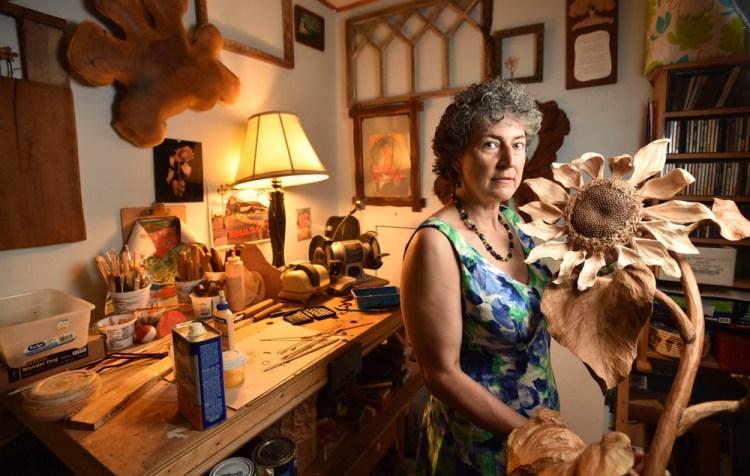CANTON — For most of Laurie Sproul’s career as an artist, she created art for art’s sake. Over the last 20 years, Sproul has been carving finely detailed flowers from large blocks of wood, often driving to Portland to buy beautifully grained woods shipped north from Virginia.
But five years ago, Sproul decided to try something a little different. Deeply concerned about what she was learning about the impending effects of climate change, Sproul was desperate to address the issue in whatever way she could. Naturally, she began with her art.
“I started getting more involved in speaking out and playing a role in society so it started reflecting through my art,” Sproul said in an interview Sunday. “Realizing it wasn’t just a sunflower, it was nature is awesome, now it’s in trouble, now we have to do something about it. So it became more the art was a means to an end rather than an end itself.”
By her own admission, Sproul’s first attempts to incorporate messaging into her art were not terribly subtle. One of her first pieces, titled ‘Your Move,’ depicted a bleeding heart wrapped with a black chain representing carbon. Over time, however, and through her involvement with a climate advocacy group called the Citizens’ Climate Lobby, Sproul’s approach to using art as a means of communication has become more nuanced and, Sproul believes, more effective.
While much of her art still focuses on the beauty and richness of nature, and what we stand to lose if we fail to protect the environment, Sproul has also begun using new types of imagery to describe some of the realities of climate change. In recent shows she has put on with Winslow artist Jean Ann Pollard, who also uses her artwork for climate activism, Sproul included two series of shrinking wooden discs with contrasting messages about climate, One series, called ‘The North Pole,” depicts the melting of the Arctic ice cap. The other, titled ‘Lifeline,” is made up of discs marked with the names of Maine organizations that have committed to reducing their carbon footprints.
“The point was to help people see there is a lifeline out there,” Sproul said. “There is a community effort and it’s not totally hopeless.”
Even Sproul’s wild flowers have changed in their purpose and presentation. One of her more recent sunflower carvings, titled ‘From the Woodshed,’ speaks to Sproul’s attempts to reduce her impact on the planet. Instead of traveling to purchase wood for her sculptures, Sproul has turned to trees in her own backyard, cutting down on her carbon emissions and removing herself from the Virginia to Maine supply pipeline.
As she has undergone this transition from artist to communicator, Sproul has realized that if she can create something attractive that draws in an observer enough to start asking questions, she can help spark broader conversations. Once someone has engaged her about one of her pieces, Sproul is ready to offer them literature from the Citizens’ Climate Lobby that describes the carbon fee and dividend model the group believes to be the most effective and market-driven approach to reducing U.S. carbon emissions.
Sproul said she has also learned that people come to the issue of climate change with different concerns. Where some may focus on the harm being done to the planet, others may worry more about how climate policy will impact their ability to support their families. Effective art and communication, therefore, must speak to a wide array of people about the things they value most.
In her trip last week to Washington, D.C., for the Citizens’ Climate Lobby’s annual climate conference, Sproul reached out to members of the group’s conservative caucus to work on imagery that might speak more effectively to conservative concerns about climate change. The first image members of the caucus sent Sproul surprised her. It was a picture of a bald eagle.
As a Mainer, Sproul has had the pleasure of watching eagles in the wild and it was those experiences that came to mind when she saw the image. She realized, however, that even if someone else looking at the picture primarily saw one of the most iconic symbols of American strength, they could share in their appreciation of the majesty of the bald eagle. She hopes that type of common ground can lead to common purpose in the urgent push to preserve the best of this country, and planet, for the future.
Kate McCormick — 861-9218
kmccormick@centralmaine.com
Twitter: @KateRMcCormick
Send questions/comments to the editors.




Comments are no longer available on this story